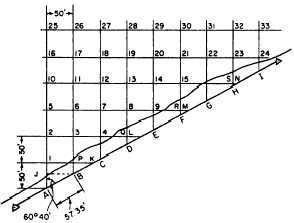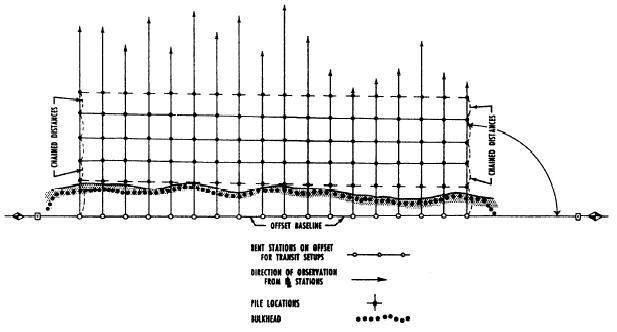|
OFFSHORE LOCATION BY CHAINING Figure 10-28 shows a situation in which offshore locations of piles for a
wharf were determined by chaining. We will call each series of consecutive piles
running offshore a line and
each series running parallel to the shore a row.
Alignment for each line was obtained by transitset up on a shore
base line offset from the inboard row of piles. In each line the distance from
one pile to the next was chained, as shown.
In figure 10-28 the lines are perpendicular to the base
line, which means that the angle turned from the base line was 90 and the
distance from one transit setup to the next was the same as the prescribed
distance between lines. If the lines were not perpendicular to the base line,
both the angle turned from the base line, the distance from one transit setup to
the next, and the distance from the base line to the first offshore pile in each
line would have to be determined.
Consider figure 10-29, for example. Here the angle
between each line and the base line (either as prescribed or as measured by
protractor on a plan) is 6040. You can determine the distance between
transit setups by solving the triangle JAB
for AB, JA
being drawn from transit setup B
perpendicular to the

Figure 10-29.Offshore location in line oblique to the base
line.

Figure 10-28.Offshore
location by chaining
line from transit setup A through
piles 1, 2, 5, 10, 16, and
25. AB measures
50/sin 6040, or 57.35 feet. This, then,
is the distance between adjacent transit setups on the
base line.
The distance from the base line to the first offshore pile
in any line also may be determined by right-triangle
solution. For pile No. 1 this distance is prescribed
as 50 feet. For piles 2, 3, and 4, first solve the triangle A2L
for 2L, which
is 100/tan 2920, or 177.95 feet. The distance from 2 to Q
is 150 feet; therefore, QL
measures 177.95 150, or 27.95 feet.
QD amounts
to 27.95/tan 6040, or 15.71 feet. Therefore, the distance from transit setup
D to
pile No. 8 is 50 + 15.71, or 65.71 feet. Knowing the length of
QL and
the distance from setup point B
to pile No. 3 by solving
the right triangle LB3 for
B3.
You can determine the distance E9
by solving the right
triangle M5A and
proceeding as before. You can determine the distance F15,
G22, and H23 by
solving the right triangle AN10
and proceeding as before. For pile No. 24, the distance I24
amounts to 50 tan 2920, or 28.10 feet.
|
|

